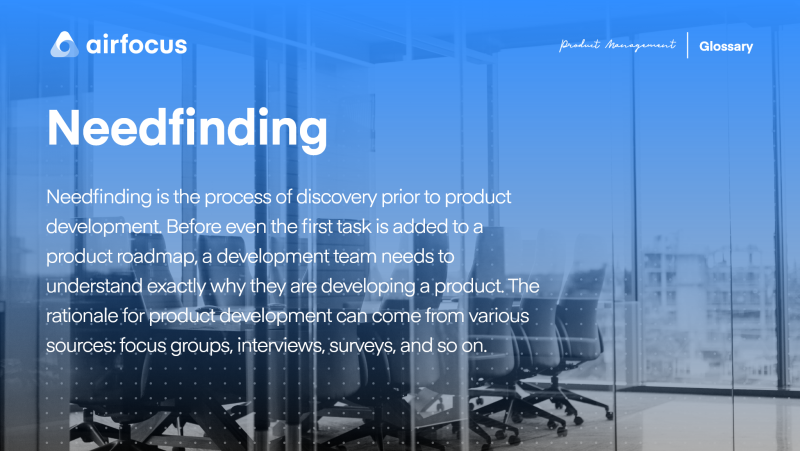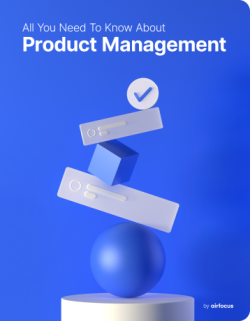Needfinding
What is Needfinding
Definition of Needfinding
Needfinding is the process of discovery prior to product development. Before even the first task is added to a product roadmap, a development team needs to understand exactly why they are developing a product. The rationale for product development can come from various sources: focus groups, interviews, surveys, and so on.
But it’s the content of this rationale which is what really informs the design of a product. More specifically, it’s the needs your customers face which have the biggest impact on how a product is designed.
What is the theory behind Needfinding?
Robert McKim developed the theory behind needfinding at Stanford University in the 1970s. Unlike other research methods, the needfinding technique disregards customer wants and focuses only on needs.
But what’s the difference?
A customer want can be defined as a feature or solution a customer finds desirable based on their subjective experience.
Like that famous quote from Henry Ford: “If I’d asked people what they wanted, they’d have said faster horses”.
This is a good example of a customer want — but what is the need?
Not necessarily. The reason Ford came up with an upgrade to faster horses is that he focused on the need of the customer. In his case, it was that people needed to get around faster. By circumventing the want and focusing on the need, Ford changed the world.
That’s why needfinding is such a powerful tool.
What are the four stages of the Needfinding process?
The process of needfinding, as proposed by Robert McKim, is based around the observation and study of people. This involves a blend of techniques including interviews carried out by researchers as well as close observations in real-world scenarios.
The needfinding process can be broken down into four distinct stages which we’ll detail below. Once each stage is completed, researchers will collate and analyze their data to discover the customer insights which will inform the product’s design.
Here are the four stages of the needfinding process:
1. Frame and Prepare
As with any other form of research, needfinding begins with good preparation. Before any researchers visit customers, they must first decide which group they want to study. Then they should formulate the questions they’d like to ask them and settle on a — preferably natural — environment in which to observe them.
2. Watch and Record
At the heart of needfinding is the idea that customers don’t really know what their needs are, but that these needs will be evident to an outside observer. This stage of needfinding requires the research team to embed themselves as naturally as possible in the world of the customer to witness needs in real terms.
3. Ask and Record
While the observation of people is a solid way to identify a need, it doesn’t tell the whole story. For this reason, research teams are encouraged to ask clarifying questions where necessary and to record the responses. This should take place in the customer’s own environment and on their terms.
For example, if you’re designing a cooking app, it would be wise to go and spend time with prospective users in their kitchens. Asking them what features they’d find useful while they prepare dinner is an insightful way to research and will deliver much more realistic findings versus asking them in an interview room at 11 am in the morning.
4. Interpret and Reframe
The final stage is to collate the collected data and distill it into a final list of core needs. Needfinding is often an iterative process, meaning this data can also be used to formulate a new set of questions to be used by a different research team with a different set of customers.
Needfinding and design thinking
Needfinding and Design Thinking share many of the same values.
As we’ve already discussed, needfinding is all about uncovering the real need behind a user request or behavior.
It’s about digging deep to find the (sometimes unspoken) truth by watching, asking, recording, and interpreting users in action.
In a very similar way, the widely-used process of Design Thinking also begins with empathy — understanding what the user needs and wants; what their potential wins and pain points are. Following that, Design Thinking develops a product incrementally, using research and prototype testing to continuously learn and improve product ideas.
Product teams can unlock all-new insights by using needfinding and Design Thinking together. Needfinding is the ethos product teams should embrace during product discovery, then the rest of the Design Thinking framework can be followed — define, ideate, prototype, test — to design and launch products that users really need.
Needfinding questions and interview tips
User interviews and direct observations are the greatest sources for the needfinding process.
And the needfinding questions you ask can be make-or-break when it comes to gleaning the most powerful insights.
You'll need to look at how consumers are currently resolving the issue your product will solve. Then you’ll need to ask the kind of questions that ladder up from a particular behavior and help uncover an unmet need.
So which questions are most efficient in needfinding interviews? Open-ended questions work all the time, while closed questions are what you should avoid. If a user can just answer ‘no’ or ‘yes’ to a needfinding question, then you won’t get very far with your research.
For example, the types of open-ended questions you’ll want to ask in needfinding interviews are:
”Tell me more about why you…”
”Show me how you use…”
”Let’s imagine you’re doing X, how would you do that…?”
”If you were telling a friend about X, how would you describe it…?”
”How well does X enable you to Y right now?”
”Why don’t you begin by telling us a little about what you’re trying to achieve when…”
”What are you exactly doing here?”
”How does a typical day of X look?”
”How many customers of yours fall into the X category?”
”Can you show me how to make…?”
”In what ways are things different now than they were last year?”
It takes a lot of work to become a great needfinding interviewer, but practice always makes perfect. It's essential that you consider what wants your customers may have and what drives these needs. Do any of your ideas address the deeper, root issue?
Here are our top tips for needfinding questions and interview skills:
Be focused without fixating - You’ll want to achieve a balance of being focused on the task without becoming tunnel-visioned on a certain need state or area. In needfinding, you want to be open to discovering a variety of possible solutions — many of which might be even more effective than your original product idea.
Ask “why” questions as often as possible - Needs show up as feelings, decisions, and motivations. You can uncover them by always asking “why?”.
Do not sell - Needfinding is all about understanding the needs of the customer. You’re not there to persuade them that your idea is valid.

General FAQ

Glossary categories
Experience the new way of doing product management

Experience the new way of doing product management








